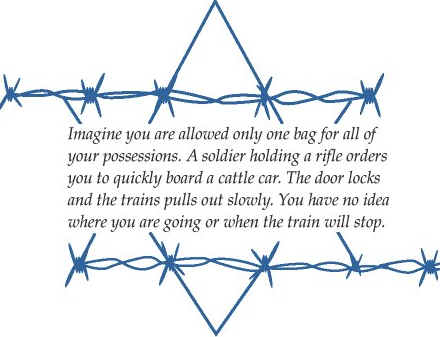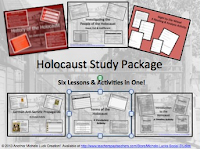
As I end each school year with my students, I want to leave them with a lesson they will never forget. I want to teach them about the world, about life, and about themselves. I want them to know that the world is what they make it, and that the by-standers of the world will only become its next victims. To teach these important lessons, I use the example of the Holocaust.
First, let me discuss the lessons that are still very real-world for our students that can come from the Holocaust:
- Religion can be a backdrop for any event we discuss in history or in modern day. This does NOT mean that any particular religion is responsible for the actions of individuals who perpetrate these atrocities. If we talk about the Holocaust, we are discussing the attack on the Jews by Christians. Yet, the big lesson is that Christianity did not act out this crime, individual Christians did. More importantly, if those individual Christians actually followed the doctrine of their religion, they would never have acted in the way they did. This same message can be shared about the 9/11 attacks. Those responsible for the terrorist attacks were individual Muslims who acted against the most important tenants of their religion while claiming they were performing as a response to its demands.
- By-standers allowed the Holocaust to become as deadly as it did. While atrocities happen all around the world, the numbers of the victims rise as the number of by-standers increases. Every individual in the world is responsible for those around them, and our inaction can sometimes be just as bad as others’ action. In the Holocaust, many turned in their friends and neighbors, claiming they feared for their own safety. If the entire population had refused to cooperate, or if other nations of the world had refused to stand by and ignore the signs (many signs of the persecution), the outcome would have been very different. This lesson is one more often seen on a personal level for our students… Bullying. How often do we all stand by as someone else is picked on or humiliated by others?
- Knowing who we are is humbling, yet also fills us with a sense of obligation to the world we all live in. The more we know about ourselves, the less we should be willing to persecute others at any level. As our world becomes more and more interlinked, we find that we are no longer individuals without anything in common with those around us, or even those far away from us. We all share hopes, dreams, and aspirations. Moreover, we all have flaws. And if we want to talk genetics, as done by Hitler, the US government (sterilization programs and segregation practices throughout history), or even the KKK and other hate groups, we can now see that all of our genetics take us back to a singular shared origination. This does not matter what religion or civilization you claim as your own, we all share common genetics. And, in our modern times, our genetic mix is becoming more and more diluted with each generation. Why look for these differences? Why not look for the commonalities?
- Those who fail to learn history are doomed to repeat it! This lesson is often the one overlooked, but should be the most important. Why can we not learn the lessons of our past? If the people of Europe had learned from the past, they would have known what was coming. Same message could be shared in America every day as we step into the same traps. Even in our personal endeavors, we make the same mistakes over and over. Why is this such a challenge?
Next, I want to share how I inform my students on the horrific events and how I allow my students to learn the important lessons through their own investigation and discovery:
- I always start my unit with a Silent Timeline Activity. The silence is important because it sets the stage for the significance of the topics that will be read once the students have arranged themselves into chronological order. Also, students quickly realize the the Holocaust did not erupt with the coming to power of Adolf Hitler, but followed long-standing anti-Semitism across Europe. In addition to this one activity, each timeline card can lead to a number of other lessons valuable in the study of the Holocaust and its significance.
- A Complete Lecture Outline of the History of the Jews and the Holocaust helps students to organize the key information significant in the unit. Students begin to evaluate the rise of the hatred across Europe, and are able to see how someone like Hitler could lead to such a devastating event.
- Once students understand WHAT happened, and how it came about, it is important to introduce them to the terms of the event. So many vocabulary terms are significant in the Holocaust. One of my favorite scenes in Schindler’s List is Stern informing Schindler that “special treatment” is not a good thing. As important as the terms themselves is the image that comes with them. A Vocabulary Visualization Activity helps students to develop the understanding and the importance with those images.
- Dividing up the People of the Holocaust helps students to see the significance of the many different groups and individuals involved. As students investigate the varying groups, and their impact, it helps them to start to see how things could have been different based on individual decisions.
- At this point in the lesson, I want my students to begin to place themselves into the event to understand the impact they could have had then, and the impact they could have now. More importantly, I want them to realize the significance of their situation in any event, and how what they perceive over time may change as facts become more clear. Who Am I? Activities help students to begin this self-reflection. This FREE set of materials also includes response sheets for reflecting on different events, different situations, and their own thoughts and feelings on the world and its people.
- Depending on the time available in your classes, I could recommend many visual or literary activities to help make the unit more impactful for your students. I always showed all or parts of Schindler’s List, emphasizing the role of the by-standers and the heroes. In addition, I showed Nuremberg (the TV version with Alec Baldwin) to show real footage clips and the response of the nations after the fact. Finally, I have my students read many different accounts of the Holocaust for reflection. One of the greatest resources are the ID Cards available for download from the United States Holocaust Memorial Museum. These were used as my bell-ringer each day, with students reading a card, sharing their person with a neighbor student, and then reflecting on the individual stories. In addition, we read aloud always as a whole class and then individually completing the reading guide, Night by Elie Wiesel.
- My next lesson is on the Propaganda used by the German government (and others) in the persecution of the Jews. I stress that students need to be able to evaluate the propaganda around them and to discern what is positive and negative in nature. I also encourage my students to look for the fact in the fiction or vice-versa with much of the propaganda produced by all of the governments discriminating against any group.
- The final activity is an investigation and research activity on the Ties of the Holocaust to Today. This helps students see that it is still relevant discussion, and that their action or inaction is still very important in our modern times. As students see that Hate Groups are still very prevalent, and that atrocities and genocides are still occurring in our world, they are more willing to see their role in world events.
- Finally, the Self-Reflection Materials are utilized again, asking students to re-evaluate themselves and their role in daily events or in major atrocities. This message becomes clear as students compare their earlier response to this one in the end of the study.
Many school administrators and districts will argue that you do not have the time or resources available to teach this unit. Considering the bullying, acts of terrorism, and other atrocities in our modern world, I argue that you do not have the time to NOT teach it!

Complete Holocaust Unit with all above activities included (except Night Reading Guide) available in my TpT Store.
Michele
My TpT Store
Additional Resources & Websites:
United States Holocaust Memorial Museum
A Teacher’s Guide to the Holocaust
Teaching Tolerance
Simon Wiesenthal Museum Tolerance Center